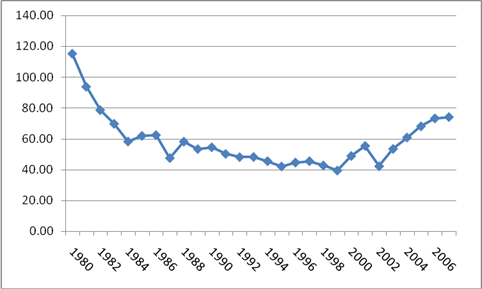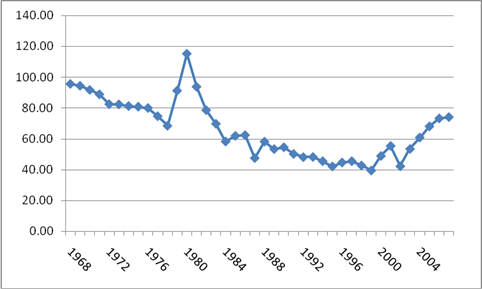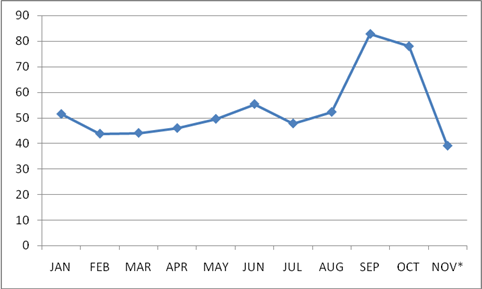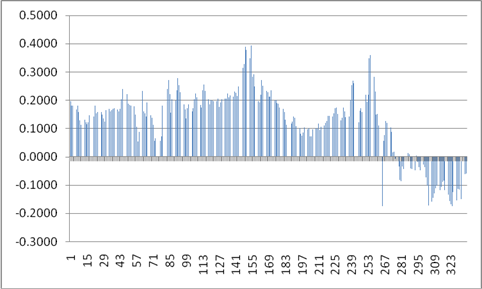In an interesting bit of happenstance, last weekend’s Maryland Republican Party Fall Convention was held at the same time and same venue as the MDV-SEIA Solar Energy: Focus 2009 Conference & Exhibition, which brought together exhibitors and those interested in solar energy around the capital region. (We kicked them downstairs for Saturday, which shows me Doubletree has its priorities correct. Capitalism before wackoism.) Since the mission of the MDV-SEIA is to “speak out on solar legislation, codes and standards issues in Richmond, Annapolis and the District, seeking better financing and broader consumer awareness,” I thought it would be a good idea to see just how much “better financing” they’re getting now. (Emphasis mine.)
Obviously there are a number of businesses which deal in solar energy, and the bulk of the exhibitors (I’m guessing there were around 20) were companies who sell or install solar panels. Probably the most known, and one who actually has a solar panel manufacturing facility in Frederick, Maryland, is BP Solar – obviously a subsidiary of British Petroleum (corporately known as BP plc.) They’re quite helpful in the “better financing” regard, with a area on their website devoted to rebates and incentives for installing solar panels (read: redistribution of tax money as subsidies.) Maryland is one of 24 states who have enacted financial incentives to install solar panel systems; surprisingly to me we were one of the most miserly in that regard – only Utah had a smaller allowance than Maryland’s $3,000 while Wyoming’s was equal. (By comparison, Delaware’s incentive as listed is fifth highest at $20,000.) BP’s information is a little out of date, though, as I’ll detail later.
While BP is pleased to share the costs borne by government of its solar program, it’s much more difficult to determine its impact on the corporate bottom line. Effective in 2008, BP placed its alternative energy subsidiaries in a grouping with overall corporate operations, and through the third quarter this area was their lone loser among BP’s various businesses. (You can find the breakout on Page 10 of this document. Notice U.S. operations take the biggest toll.) Not being an accountant by trade, I’m still led to assume that the alternative energy portion of BP’s business is the loss leader, but serves them a little bit of a shield against criticism from the extreme environmental left.
However, BP itself hasn’t been left off the subsidy train. A pamphlet I picked up at the event glowingly notes, under “Investing in Communities”:
BP Solar has been awarded a U.S. Department of Energy grant under the Solar America Initiative (SAI) to accelerate the path to grid-parity (bringing the cost of solar on par with traditional brown power). This ~$40 million effort encompasses all levels of the manufacturing and deployment steps for residential and commercial applications.
The SAI is part of the laundry list of programs for energy independence President Bush outlined in his 2006 State of the Union Address, and that $40 million is a big chunk of the $148 million he proposed in FY2007. Fiscally conservative that’s not.
As you can tell already, many of these exhibitors wouldn’t be there if not for a large heap of federal money. But the state of Maryland, and at least one locality within, is not immune to shoveling tax money toward homeowners who believe solar energy may be right for them.
One bill (HB377) which passed the 2008 General Assembly increased Maryland’s former $3,000 cap on solar grants to $10,000, divvied out as $2,500 per installed kilowatt. But according to the Maryland Energy Administration, the full budget allocation for these grants was wiped out in one day of applications, and they’ve stopped taking applications for the FY2009 waitlist for money to replenish the grants extorted from utility companies and others who participate in the Regional Greenhouse Gas Initiative cap-and-trade program. They’re now starting to take applications to wait for reimbursement in 2010.
If that’s not enough, residents of perhaps the greatest socialist’s paradise in America – Montgomery County – have the opportunity to participate in their “Clean Energy Rewards” program. Of course, it comes at a cost to the consumer:
County residents, businesses, and other organizations will receive a half a cent ($0.005) for each kilowatt-hour (kWh) of program eligible clean energy used. Depending on the product selected the cost of clean energy through the program ranges from 1.5 to 3.5 cents more than standard electricity (10/14/08).
There’s also a cap to the program of 20,000 kWh annually for residences and 400,000 kWh annually for businesses. All this does then is subsidize a small portion of the out-of-pocket cost to those who feel guilty enough after being browbeaten by the radical environmentalists out there to decide to fork over a premium price for the same exact form of energy that the most polluting coal-fired plant produces at a much better price. Even in a best-case scenario for a homeowner who uses 20,000 kWh, they’re paying a $300 premium to get a $100 check from the government.
Clean Energy Rewards is not the only scam Montgomery County promotes, they also encourage the purchase of renewable energy certificates as well. Once again, this is done to create a market for alternative energy where none exists, and again taxpayers pay for a reward that’s a pittance compared to the actual costs. (But it also keeps a few pencil pushers employed too.)
Job creation is a good place to finish my look at this subject. Many claim that green-collar jobs are the wave of the future, and there was one start-up business present at the trade show with a mission to “create permanent green-collar jobs that support an environmentally sustainable locally-based economy.” Another little handout I picked up last weekend was from a group called the Worldwatch Institute, who claimed that “(b)y 2006, the U.S. renewables industry had created 386,000 jobs compared to 82,000 jobs in the coal industry.” Perhaps that’s true, but the renewables industry pales greatly in comparison to the over 1.6 million jobs currently held by those working in the oil and gas industry. Nor does the Worldwatch Institute give a time frame for that job creation purportedly in the renewable energy field.
As a whole, I have nothing against those who wish to invest in solar power for whatever reason – if they have the resources to do so and feel it’s right for them, go for it. The same goes for companies who have a better idea in that realm of technology. But it should be up to the market to determine winners and losers, and my biggest problem with the heavy government involvement and subsidy of that industry for the dubious purpose of preventing climate change is that there are so many other priorities our federal and state governments should be funding first, well before engaging in corporate welfare of this type.
While the nation argued for days about a $15 billion bailout of the Big Three, we seem not to notice the billions in subsidies and tax breaks that go to make renewable energy cost about the same as those fossil fuels we hold in abundance, but which may not be as politically correct to use. Someday solar energy will have its place, but the economics of today suggest that day isn’t here yet.






